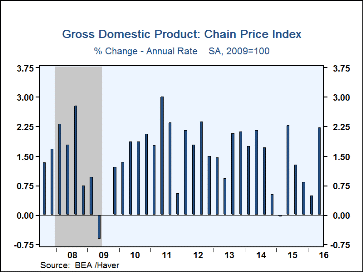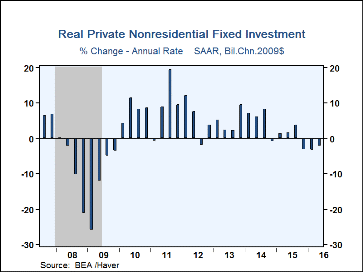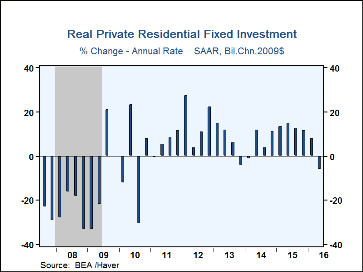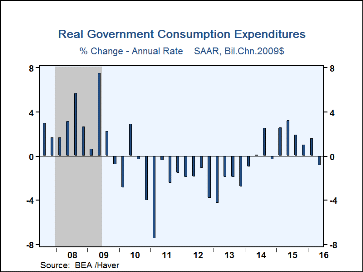 Global| Jul 29 2016
Global| Jul 29 2016U.S. GDP Growth Disappoints as Inventories Are Reduced
by:Tom Moeller
|in:Economy in Brief
Summary
Economic growth of 1.2% (SAAR, 1.2% y/y) during the second quarter followed a 0.8% Q1 gain, revised from 1.1%. GDP's increase disappointed expectations for a 2.6% rise in the Action Economics Forecast Survey. Inventory decumulation [...]
Economic growth of 1.2% (SAAR, 1.2% y/y) during the second quarter followed a 0.8% Q1 gain, revised from 1.1%. GDP's increase disappointed expectations for a 2.6% rise in the Action Economics Forecast Survey. Inventory decumulation subtracted 1.2 percentage points from GDP growth. It was the largest of five consecutive quarterly subtractions. Growth during 2015 was revised to 2.6% from 2.4% estimated earlier. The GDP price index increased 2.2% (1.2% y/y), the quickest increase in a year. A 1.9% rise had been expected.
Accompanying the slowdown in overall output growth, domestic final demand improved. A 2.1% rise (2.0% y/y) in domestic final sales was the quickest increase in three quarters. Consumer spending growth led the improvement with a 4.2% rise (2.7% y/y), the quickest gain since Q4'14. It was led by an 8.4% rise (4.4% y/y) in durable goods purchases. Recreational goods & vehicle buying jumped 14.3% (9.3% y/y), the quickest rise since Q1'12. Spending on home furnishings & appliances rose 8.3% (6.8% y/y) and motor vehicles buying gained 4.5% (-0.8% y/y). In the nondurable goods area spending rose 6.0% (3.1% y/y), powered by an 8.6% gain (2.7% y/y) in food & beverage spending. Apparel buying rose 4.1% (1.5% y/y), but gasoline & fuel oil purchases fell 1.2% (+2.4% y/y). Spending on services strengthened 3.0% (2.3% y/y), the largest increase since Q4'14. It reflected a strengthened 4.2% rise (1.2% y/y) in housing & utilities and a 3.8% increase (4.2% y/y) in medical care. Recreation spending declined, however, at a 4.5% rate (+1.3% y/y).
Outside of personal spending, final demand declined. Business fixed investment fell at a 2.2% rate (-1.3% y/y), the third consecutive quarterly shortfall. Structures spending fell 7.9% (-7.0% y/y) and equipment purchases were off 3.5% (-1.9% y/y). Computer purchases declined 5.9% (+3.8% y/y) but industrial equipment buying gained 12.0% (3.1% y/y). Purchases of intellectual property products rose 3.5% (3.5% y/y).
Residential investment declined at a 6.1% annual rate (+6.2% y/y), the first decline since Q1'14.
Spending by governments eased 0.9% (+0.9% y/y) as state & local government purchases fell 1.3% (+1.0% y/y). Federal government spending eased 0.2% (+0.7% y/y), but defense spending declined 3.0% (-0.8% y/y).
Foreign trade added 0.2 percentage points to overall economic growth. The addition was due to a 1.4% rise in exports (-1.2% y/y) following three straight quarters of decline. Goods exports rose 2.7% (-1.3% y/y) while services exports eased 0.9% -1.1% y/y). Imports slipped 0.4% (+0.2% y/y), off for the second straight quarter. Goods imports fell 0.9% (-0.4% y/y), but services imports gained 1.5% (2.9% y/y).
The GDP price index increased 2.2% (1.2% y/y) as the residential investment price index jumped 5.2% (3.1% y/y). Higher energy prices raised the PCE price index 1.9% (0.9% y/y). Excluding food & energy, the PCE price index increased 1.7% (1.6% y/y). The business fixed investment price index gained 1.1% (0.5% y/y).
The GDP figures can be found in Haver's USECON and USNA database. USNA contains virtually all of the Bureau of Economic Analysis' detail in the national accounts, including the integrated economic accounts and the recently added GDP data for U.S. Territories. The Action Economics consensus estimates can be found in AS1REPNA.
| Chained 2009 $ (%, AR) | Q2'16 (Advance Estimate) | Q1'16 | Q4'15 | Q2'16 Y/Y | 2015 | 2014 | 2013 |
|---|---|---|---|---|---|---|---|
| Gross Domestic Product | 1.2 | 0.8 | 0.9 | 1.2 | 2.6 | 2.4 | 1.7 |
| Inventory Effect | -1.2 | -0.4 | -0.4 | -0.7 | 0.2 | 0.0 | 0.2 |
| Final Sales | 2.4 | 1.3 | 1.2 | 1.9 | 2.4 | 2.5 | 1.5 |
| Foreign Trade Effect | 0.2 | 0.0 | -0.5 | -0.1 | -0.7 | -0.1 | 0.3 |
| Domestic Final Sales | 2.1 | 1.2 | 1.7 | 2.0 | 3.1 | 2.6 | 1.2 |
| Demand Components | |||||||
| Personal Consumption Expenditures | 4.2 | 1.6 | 2.3 | 2.7 | 3.2 | 2.9 | 1.5 |
| Business Fixed Investment | -2.2 | -3.4 | -3.3 | -1.3 | 2.1 | 6.0 | 3.5 |
| Residential Investment | -6.1 | 7.8 | 11.5 | 6.2 | 11.7 | 3.5 | 11.9 |
| Government Spending | -0.9 | 1.6 | 0.1 | 0.9 | 1.8 | -0.9 | -2.9 |
| Chain-Type Price Index | |||||||
| GDP | 2.2 | 0.5 | 0.8 | 1.2 | 1.1 | 1.8 | 1.6 |
| Personal Consumption Expenditures | 1.9 | 0.3 | 0.4 | 0.9 | 0.3 | 1.5 | 1.3 |
| Less Food/Energy | 1.7 | 2.1 | 1.2 | 1.6 | 1.4 | 1.6 | 1.5 |
Tom Moeller
AuthorMore in Author Profile »Prior to joining Haver Analytics in 2000, Mr. Moeller worked as the Economist at Chancellor Capital Management from 1985 to 1999. There, he developed comprehensive economic forecasts and interpreted economic data for equity and fixed income portfolio managers. Also at Chancellor, Mr. Moeller worked as an equity analyst and was responsible for researching and rating companies in the economically sensitive automobile and housing industries for investment in Chancellor’s equity portfolio. Prior to joining Chancellor, Mr. Moeller was an Economist at Citibank from 1979 to 1984. He also analyzed pricing behavior in the metals industry for the Council on Wage and Price Stability in Washington, D.C. In 1999, Mr. Moeller received the award for most accurate forecast from the Forecasters' Club of New York. From 1990 to 1992 he was President of the New York Association for Business Economists. Mr. Moeller earned an M.B.A. in Finance from Fordham University, where he graduated in 1987. He holds a Bachelor of Arts in Economics from George Washington University.












